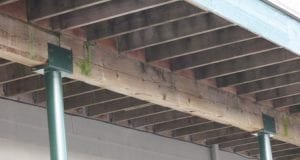Last Updated on December 9, 2024 by teamobn
Have you ever dealt with moisture damage in a home or commercial space? If so, you know how quickly it can ruin a property, from warping wood to growing mold and spreading mildew.
While access panels are often used for effortless access to important systems, a standard panel might not be enough in areas where moisture is a concern. Gasketed access panels solve this problem with their tight seal that keeps moisture out.
This article will discuss what these access panels are, their types, features, benefits, and factors you should consider when choosing one.
Contents
- 1 What Causes Moisture?
- 2 The Consequences of Moisture on Built Environment Structures
- 3 What Are Gasketed Access Panels?
- 4 Key Features of Gasketed Access Panels for Moisture Protection
- 5 Benefits of Installing Gasketed Access Panels
- 6 Choosing the Right Size for Gasketed Access Panels
- 7 Key Applications in Construction and Facility Management
- 8 Conclusion
What Causes Moisture?

First, let’s talk about what causes moisture to form. Moisture can damage a building, cause energy loss, and be a health hazard due to mold growth. Here are five common sources of moisture:
Here are common causes of moisture:
- High Humidity Levels: This occurs when indoor humidity exceeds recommended levels of 30-40%. It often results in condensation forming on cold spots such as walls, windows, or pipes. High humidity eleven usually occurs in areas like bathrooms and basements, where water usage and poor ventilation compound the issue.
- Leaks in Plumbing or Roofing: Faulty pipes, damaged roofs, or leaky gutters are a common source of water intrusion in unwanted areas. These leaks can be sneaky and only become apparent once signs like water stains or mold appear.
- Improper Drainage Systems: A well-designed drainage system keeps water from touching the property. If the drainage system is blocked or less effective, water pools next to the foundation, causing seepage in the basements or crawl spaces.
- Poor Waterproofing: Areas exposed to water, such as bathroom floors, kitchen backsplashes, or exterior walls, require strong waterproofing to prevent water intrusion. Over time, worn seals, cracked tiles, or deteriorating caulking can allow moisture to seep through and damage the underlying materials.
The Consequences of Moisture on Built Environment Structures
Moisture intrusion is one of the sources of several problems in commercial or residential areas. Its impact goes beyond evident signs such as peeling paint or a bulging floor. Hidden issues, such as damaged utilities, weakened structures, and excessive moisture penetration, can result in substantial costs and regulatory implications.
For contractors, these issues must be resolved fast and correctly to ensure the final product’s quality and client satisfaction. However, facility managers look for a time-efficient and economical means of maintaining and operating costs. Gasketed access panels are an ideal compromise to deliver these two requirements.
What Are Gasketed Access Panels?
Gasketed access doors and panels are designed to create secure, moisture-resistant access to utility areas within a building, including mechanical systems, electrical components, etc.
The perimeter is lined with a gasket—a flexible sealing material usually made from silicone, neoprene, or rubber. When the panel closes, the seal is airtight and watertight to prevent water, moisture, air drafts, and dust from passing through to the space behind the component.
Key Features of Gasketed Access Panels for Moisture Protection
These access panels are important for moisture protection in damp areas with high humidity or frequent water exposure. To understand them better, here are some of their key features:
Moisture Barrier
The gasket ensures an effective seal to prevent water from penetrating the closed space. This is important because, in most cases, such exposure to water will result in damage, especially in basements, bathrooms, or utility rooms.
Rust and Corrosion Protection
The gasketed seal provides metal parts of the panel with effective protection against corrosion. Seals prevent water from penetrating and ensure that panels are tough and functional, reducing the possibility of rusting and crumbling over time.
Improved Thermal Insulation
The tight seals enhance thermal insulation, keeping temperatures more stable. This results in less risk of condensation, which could otherwise encourage mold and mildew growth.
Benefits of Installing Gasketed Access Panels
Gasketed access doors and panels are a great addition to areas that require moisture control. Here are some of their benefits:
- Moisture Protection: As said, the gasket provides a watertight seal that prevents moisture from entering. It is essential for high-humidity areas like basements or bathrooms.
- Enhanced Durability: Enhanced Durability: Designed for challenging conditions, these panels deliver reliable performance while retaining their effectiveness.
- Energy Saving: A gasketed panel limits air flow and allows for stable temperatures. This reduces heating and cooling costs, especially in energy-sensitive buildings.
- Noise Reduction: The seal inhibits some sound transfer from one area to another, producing a quieter, more comfortable environment for occupants.
Choosing the Right Size for Gasketed Access Panels
Selecting a gasketed panel for a specific project or facility is not a one-off decision. You must keep several considerations in mind the following:
1. Material Selection
- Galvanized Steel: Inexpensive and durable, it is best suited for indoor areas.
- Aluminum: Lightweight and rust-resistant, ideal for places with high humidity, such as kitchens or washrooms.
- Stainless Steel: Exceptionally strong and corrosion-resistant, perfect for applications with a lot of moisture or chemical exposure.
2. Gasket Type
Different gaskets are made for different purposes. For example:
- Silicone: Silicone is highly flexible and heat resistant, which makes it ideal for areas subject to extremely high temperatures.
- Neoprene: Durable and well-suited for industrial use due to its chemical resistance.
3. Compliance and Certification
It is important to check whether the panel complies with building regulations and strict safety standards, especially for commercial and industrial applications.
4. Aesthetics
Modern construction emphasizes designs that blend effortlessly with their environment. Gasketed panels frequently come with customizable finishes that match walls, making them a great choice for those looking to maintain the aesthetic of their spaces.
5. Installation Process
Most panels, like the HDSS-6020 duct access door, are particularly known for their ease of installation, thanks to their self-stick frame. Choose a product designed for easy installation to experience a hassle-free setup.
Key Applications in Construction and Facility Management
You might wonder, “Do I need one of these panels?” The answer lies in where they will be placed. Here are some of the few spaces where they’re essential:
1. Commercial Bathrooms
In huge commercial spaces like offices, shopping centers, or schools, where water usage is high, access panels are invaluable. The moisture-proof ones provide reliable access to plumbing systems, enabling maintenance and repairs to be performed efficiently.
2. Industrial Kitchens
Industrial kitchens are challenging environments due to constant exposure to steam, grease, and cleaning activities. Access panels are essential for providing easy access to service areas while preventing contamination and preserving cleanliness.
They play a critical role in such settings. They deliver reliable sealing to keep contaminants out of sensitive areas while enabling maintenance teams to access service areas quickly and efficiently without compromising hygiene.
3. Utility Rooms and Basements
Working in basements or mechanical rooms can be challenging for contractors, but attic panels provide moisture-resistant protection for wires, pipes, and other HVAC components. Facility managers appreciate their low-maintenance design, especially in infrequently used areas.
4. Exterior Installations
During roof HVACs and other utility outlets, access doors help protect the internal components from rain, snow, or exposure to high temperatures.
Conclusion
Gasketed access doors and panels provide a reliable barrier that prevents moisture from sensitive spaces, improving durability and energy efficiency. Choosing the right gasketed access panel depends on the material, the location of installation, and the degree of moisture protection desired.
Investing in these panels can significantly enhance the lifespan and functionality of your infrastructure and prevent moisture-related problems.






